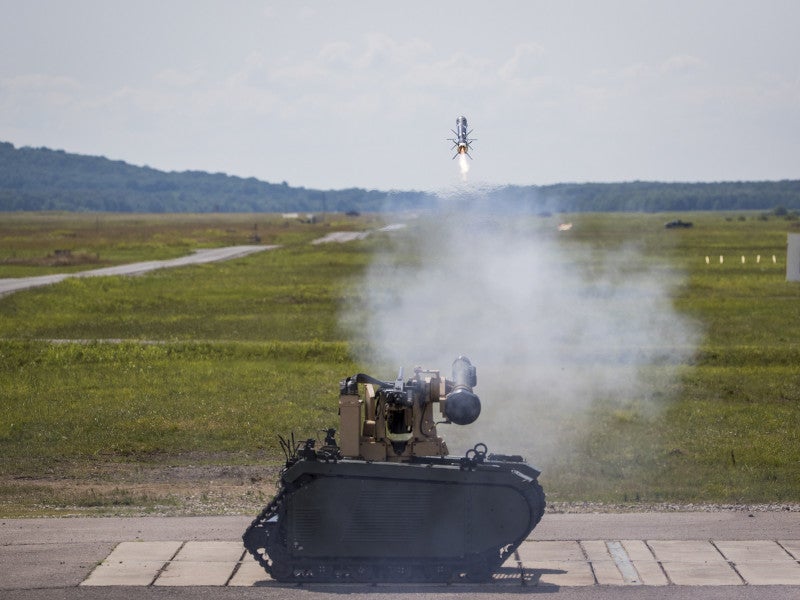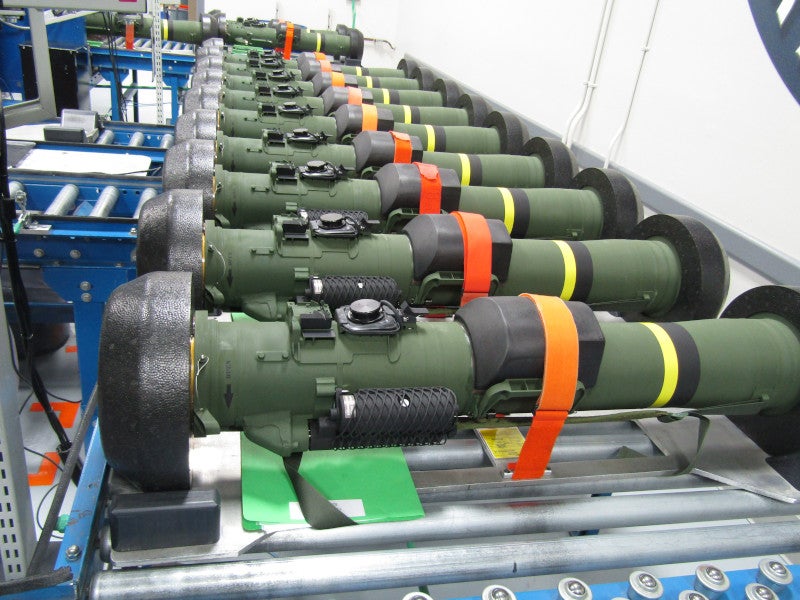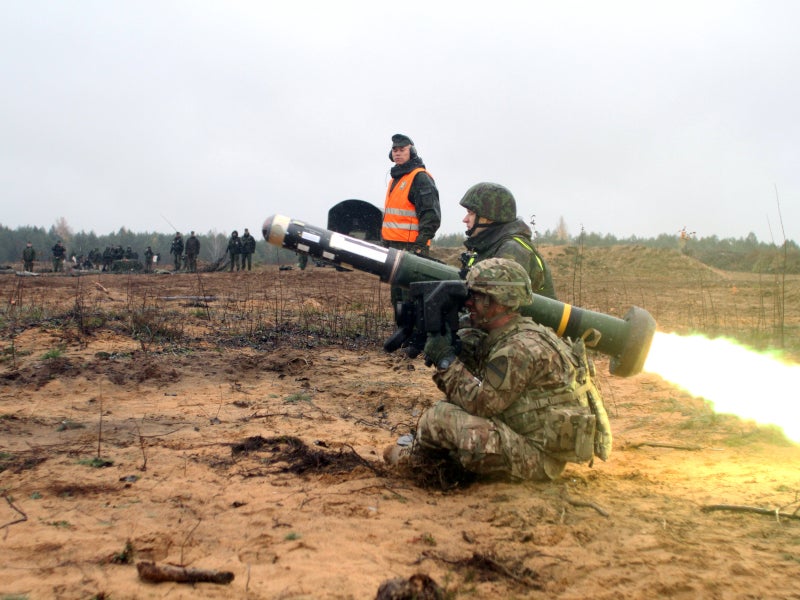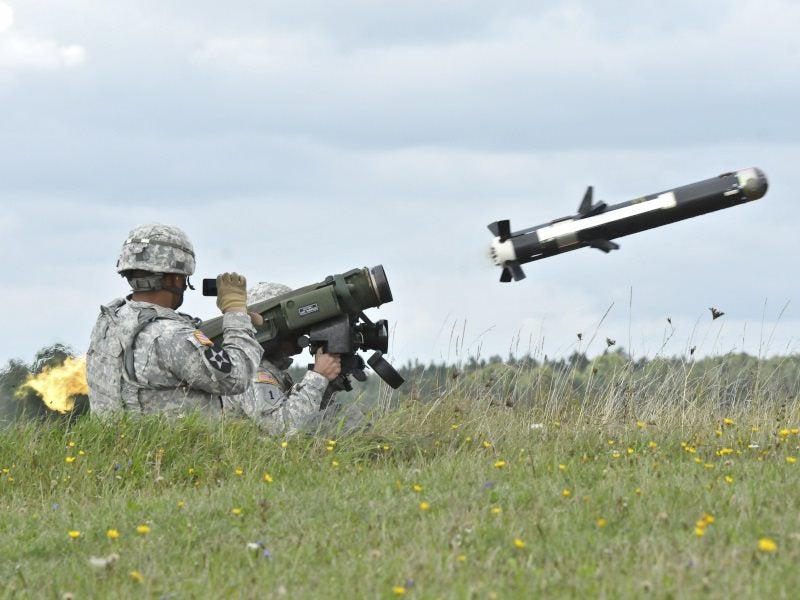Understand the impact of the Ukraine conflict from a cross-sector perspective with the Global Data Executive Briefing: Ukraine Conflict
Javelin is a portable anti-tank weapon developed by a joint venture (JV) of defence companies Raytheon and Lockheed Martin, named the Javelin JV. It is shoulder-fired but can also be deployed from multiple platforms installed on tracked, wheeled or amphibious vehicles.
Raytheon is responsible for the Javelin command launch unit (CLU), missile guidance electronic unit, system software and system engineering management, while Lockheed Martin is responsible for the missile seeker, engineering, and assembly of the missile itself.
Javelin has been deployed extensively in Afghanistan and Iraq for combat missions. The US and coalition forces have successfully conducted more than 5,000 engagements with the weapon system in Afghanistan and Iraq.
Javelin is also being widely used by the Ukrainian army against Russian tanks and armoured vehicles during the ongoing Russia-Ukraine crisis.
More than 50,000 Javelin missiles and 12,000 CLUs are currently in service within the US armed forces and over 20 allied nations. Javelin is expected to remain operational within the US until 2050.
The Javelin JV completed the first production of the Javelin F-Model missile, which features a multi-purpose warhead, in May 2020. The JV, along with Kongsberg and the US Army conducted a four-shot, multi-platform demonstration at the US Army Redstone Test Center in Alabama in May 2021.
Multiple ground platforms including Oshkosh’s Joint Light Tactical Vehicle, Qinetiq North America’s Robotic Combat Vehicle-Light, and Flyer Defense’s Ground Mobility Vehicle fired the Javelin missile at targets during the demonstration.
Two extended-range firings were performed in April 2021 from a Stryker 8×8 vehicle. A day shot and a night shot were performed successfully demonstrating Javelin’s reliability and effectiveness as an extended weapon system. The Javelin has been fielded on the Common Remotely Operated Weapon Station across the US Army Stryker brigades in Europe.
Javelin portable anti-tank missile development
In 1989, the US Army awarded a contract for the development of Javelin as a replacement for the M47 Dragon anti-tank missile. The Javelin JV was formed by Texas Instruments (now Raytheon Missile Systems) of Dallas, Texas, and Lockheed Martin Electronics and Missiles (now Missiles and Fire Control), of Orlando, Florida, both US-based companies.
Javelin entered full-rate production in 1994 and the system was first deployed in June 1996 by the US Army at Fort Benning, Georgia, US.
The Javelin system saw operational service with the US Army and Marine Corps, as well as the Australian special forces during Operation Iraqi Freedom in 2003 and is still currently deployed in Afghanistan. The CLU is also being used in surveillance operations. The standalone mode usage of the CLU was proved to be effective in target detection and battlefield reconnaissance when it was deployed in Afghanistan and Iraq. More than 2,000 rounds have been fired by the US and coalition forces.
The missile achieved a higher range of 4,750m (metres) during a demonstration in February 2013. Five Javelins were successfully fired as part of the joint exercise, called Yudh Abhyas, between the Indian and US armies in June 2013. A Javelin missile was successfully test-fired from a turret at Cranfield Ordnance Test and Evaluation Centre in May 2014.
The Javelin JV demonstrated the launch of the missile from a wheeled vehicle’s remote weapon station in July 2014.
The Javelin missile was fired from a Titan unmanned ground vehicle using a Kongsberg remote launcher in September 2019.
Javelin for light forces, an anti-tank guided weapon system
In January 2003, the UK Ministry of Defence announced that it had decided to procure Javelin for the light forces anti-tank guided weapon system requirements. The initial order was for 18 launchers and 144 missiles. Javelin replaced the Milan system and entered service with the British army in July 2005.
Javelin equips the army’s rapid-reaction forces, including 16 air assault brigades, three commando brigades and a mechanised infantry. BAE Systems and a number of other UK companies are providing subsystems for the missiles. In October 2004, a further order was placed to equip the armoured infantry and formation reconnaissance forces from 2007, replacing the previous Swingfire ATGW.
Anti-armour missile
The Javelin system consists of a reusable CLU and modular missile enclosed in a disposable launch tube assembly. It can be used during day and night and in all weather conditions. With a carry weight of 6.4kg, the CLU incorporates a passive target acquisition and fire control unit with integrated day sight and thermal imaging capabilities.
The sight uses DRS Technologies’ second-generation thermal imaging technology, based on the standard advanced Dewar assembly. The company also provides quieter, dual-opposed piston coolers for the sight.
The gunner’s controls for the missile system are on the CLU. The day sight is equipped with 4x magnification and the night sight with 4x, as well as 12x for thermal sight.
The round consists of the Javelin missile and the ATK launch tube assembly. The missile has a range of 65m to 4,000m in most operational conditions. Javelin is a fire-and-forget missile with a lock-on-before-launch function and automatic self-guidance.
The missile is equipped with an imaging infrared seeker, which is based on a cadmium mercury telluride 64 by 64 staring focal plane array in the 8-micron to 12-micron waveband. BAE Systems Avionics is providing the infrared seekers for the British army’s missiles.
The tandem warhead is fitted with two shaped charges: a precursor warhead to initiate explosive reactive armour and a main warhead to penetrate base armour. The propulsion system is a two-stage solid propellant design, which provides a minimum smoke soft launch.
The Block 1 missile upgrade includes an improved rocket motor that reduces the time of flight, an enhanced warhead effective against a greater range of targets, as well as 2,500m of improved probability of hits/kills and improvements to the CLU and software. In 2008, the improved Block 1 missile full material release was received, and the US Army stockpiled the first production lots.
Other improvements include a digital display, software processing enhancements and a remote view of the gunner display in an RS-170 standard video format. The Javelin missile also features fragmentation for anti-personnel effects and a multi-purpose warhead with shaped charges for armoured vehicles.
Lightweight command launch unit
The Javelin JV was awarded a contract for the development of a lightweight command launch unit (LWCLU) in June 2022. The LWCLU is currently in a low-rate initial production state and is scheduled to begin deliveries in 2025.
It will enable a size and weight reduction of 30% and 25% respectively, making Javelin the lightest anti-tank guided missile system in its class. The new unit will also double the target detection, recognition, and identification and is backwards compatible with all prior Javelin missile configurations.
The LWCLU will feature sensor, display and image processing upgrades to provide high-resolution video imagery to the operator. It will also have an increased detection, recognition and identification range performance over the current Block 1 CLU.
The unit will use image blending, stabilisation, digital zoom, and local area processing to deliver optimum performance even during adverse weather conditions and the presence of battlefield obscurants.
Missile system operation
The system is deployed and ready to fire in less than 30 seconds and the reload time is less than 20 seconds. The missile is mounted on the CLU and the gunner engages the target using the sight on the CLU, by placing a curser box over the image of the target. The gunner locks on the automatic target tracker in the missile by sending a lock-on-before-launch command to the missile. When the system is locked on, the missile is ready to fire, and the gunner does not carry out post-launch tracking or missile guidance.
Unlike laser beam riding or conventional wire or fibre-optic cable guided missiles, Javelin is autonomously guided to the target after launch, leaving the gunner free to reposition or reload immediately after launch.
A soft launch ejects the missile from the launch tube to give a low-recoil shoulder launch. The soft launch enables firing from inside buildings or covered positions. Once the missile is clear, the larger propellant in the second stage is ignited and the missile is propelled towards the target. The weapon has two attack modes, direct or top attack.
The gunner selects direct attack mode to engage covered targets, bunkers, buildings, and helicopters.
The top attack mode is selected against tanks, in which case the Javelin climbs above and strikes down on the target to penetrate the roof of the tank where there is the least armour protection.
The missile is launched at an 18-degree elevation angle to reach a peak altitude of 150m in top attack mode and 50m in direct-fire mode.
Javelin anti-tank missile orders and deliveries
More than 50,000 missiles and 12,000 CLUs have been produced to date. Javelin has been selected by Taiwan, Lithuania, Jordan, Australia, New Zealand, Norway, and the Republic of Ireland.
In June 2004, the Czech Republic signed a letter of agreement with the US government to provide the Javelin system. In November 2004, the United Arab Emirates (UAE) requested the foreign military sale (FMS) of 100 Javelin launchers and 1,000 missile rounds.
In June 2006, Oman requested the FMS of 30 launchers and 250 missiles. In July 2006, Bahrain requested the FMS of 60 launchers and 180 missiles. Contracts for the supply of the missile system to the UAE and Oman were placed in July 2008. In October 2008, Taiwan requested the sale of an additional 182 missiles and 20 launchers.
Canada has also been authorised to make such a purchase but has not pursued the option to date. India had also proposed purchasing the Javelin system through the FMS route, but it preferred the Spike missile over Javelin. France also ordered 260 missiles and 76 launchers for $69m.
Production of the Block 1 missile began in 2006. Successful qualification firings took place in January 2007.
In December 2008, the Javelin JV was awarded a contract to upgrade 404 Block 0 CLUs to Block 1 configuration.
In July 2009, the Javelin JV was awarded a five-year, $298.6m support contract for the Javelin anti-tank missile and CLU. Under the contract, the US Army was provided with repair support, depot spares, training, and data. The JV received another contract from the US Army in October 2009 for the production of the Javelin close combat weapon system. The $214m contract included the Javelin missiles, CLUs, training and field support.
The Javelin JV received a $176m contract in December 2009 from the UK Ministry of Defence for more than 1,300 Javelin missile rounds and related engineering support. The delivery of the missiles began in 2010.
In August 2010, the US Army awarded a $309m contract to the JV to produce Javelin missile-firing systems for infantry troops. The first Javelin missile was fired from the Common Remote Operations Weapon Station II mounted on a Stryker IFV in December 2010.
Saudi Arabia requested a possible sale of 150 Javelin-guided missiles and 20 Javelin CLUs in November 2010.
Qatar also requested the FMS of 500 Javelin-guided missiles in March 2013, according to the Defense Security Cooperation Agency.
The Javelin JV was awarded a $176m contract in September 2013 to produce and deliver 842 Block 1 missile rounds and 120 CLUs for the US Army and its marines, in addition to the armed forces of Oman, Jordan and Indonesia.
Georgia requested to buy 410 Javelin missiles and 72 CLUs worth $75m in November 2017. Another request to purchase 82 Javelin FGM-148 missiles and 46 CLUs worth $30m was made by the country in August 2021.
In March 2018, Ukraine requested to buy 210 Javelin missiles and 37 CLUs worth $47m.
Javelin JV signed a memorandum of understanding with Bharat Dynamics, an arms and ammunition manufacturer based in India, for the joint production of the anti-tank missile system in February 2020.
In the same month, the Estonian Ministry of Defence and Estonian Defence Forces took delivery of 128 anti-tank missiles from the US as part of a contract signed between the Estonian Centre for Defence Investment and the US Department of Defense.
The sale of 200 Javelin missiles to the government of Australia was approved in October 2020, including provisions for technical assistance and programme support.
Poland requested to buy 180 Javelin missiles, 79 CLUs and related equipment for an estimated cost of $100m in March 2020. Thailand requested the FMS of 300 Javelin FGM-148 missiles and 50 Javelin CLUs in July 2021.
The US government approved the sale of 230 Javelin missiles and associated equipment worth $125m to Lithuania in December 2021.
The US Army awarded two Javelin missiles in a production contract including associated equipment and services to the Javelin JV in May 2022 with a total value of $309m. The contracts include the supply of more than 1,300 Javelin missiles funded from the Ukraine Supplemental Appropriations Act. The contract also includes orders for several international customers including Norway, Albania, Latvia, and Thailand.
The US Army awarded a $311m production contract to the Javelin JV in September 2022 for the procurement of Javelin systems and production support for the US Army, Lithuania, and Jordan. The contract also includes the procurement of more than 1,800 Javelins to replenish rounds sent to Ukraine.
The Javelin JV won an indefinite-delivery, indefinite-quantity production contract with a total ceiling of $7.2bn for the Javelin missile system from the US Army in May 2023. The contract includes the provision of Javelin systems and support for the US Army and international customers between 2023 and 2026.
In addition, the contract will provide tooling, test equipment and non-recurring effort to enable the ramp up of Javelin production to 3,960 per year by late 2026 to meet the increased global demand for the missile system.







